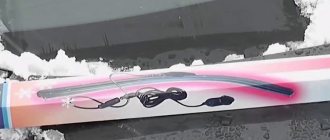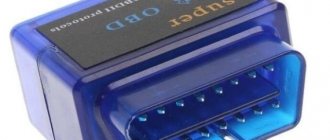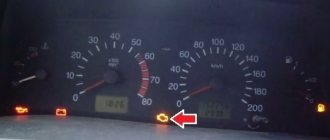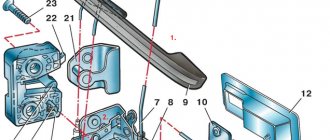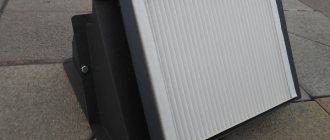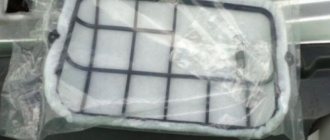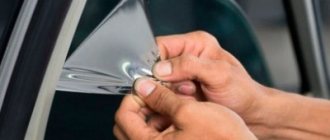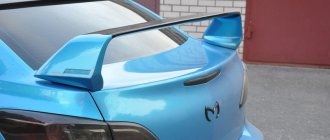The article is in the archive. 2001 - 2003
To connect the car to a personal computer, you need to purchase or create a communication interface between the COM port and the K-LINE diagnostic connector.
The first message on the screen of diagnostic equipment or a computer that causes panic among beginners is usually something like “No connection”, “No response from the controller” or something similar, but no less intriguing. For example, the motor tester starts offering options ranging from power failure to adapter hardware failure. It’s okay if a car with an immobilizer arrived for diagnostics first and you are sure that everything is in order with the adapter. The reason for the lack of communication on cars without immo is trivial and is possible only in the domestic auto industry: a break in the diagnostic line from the diagnostic connector to the ECU. The immobilizer uses line K to communicate with the ECU and is included in the diagnostic line break. If the immobilizer is not installed, the diagnostic line is suspended in the air and there is no connection with the ECU. Apparently, there was supposed to be a plug here, but... To restore communication, simply install a jumper between pins 9-1 and 18 of the immobilizer connector (or install the immobilizer) as shown in the figure. In practice, in order to preserve the gradual dimming function of the light and just to scare the first adopters, these two wires are cut and spliced, leaving the immo in the connector.
GAS diagnostic connector.
1 + 12V 2 + 12 V from battery 10 l - line 11 K - line 12 Weight
Diagnostic connector VAZ
| A - GND B - L - Line (may not exist) M - K - Line G - Fuel pump control. |
| H - 12 V. Constantly with the battery through a fuse. / may not be. |
Location of diagnostic electrodes
VOLGA - under the hood, on the wall of the engine compartment, on the passenger side VAZ 2110 - to the right of the driver, near the steering column of the VAZ 2109 Lower panel - on the shelf under the glove compartment, next to the VAZ 2109 ECU High panel - behind the center console. VAZ 2108 - 2115 “Europanel” - on the “dashboard”, closed with a hatch. Chevrolet Niva - OBD-II, next to the ignition switch, partially covered by the steering cover. VAZ 11183 “Kalina” - Under the niche for small items next to the gearshift knob. VAZ 21126 "Priora" - behind the glove compartment.
| Assignment of contacts of the diagnostic unit |
| 14 - CAN low (J - 2284) 15 - ISO 9141 - Line 2 L 16 - battery powered |
| Chevrolet Niva: The control unit is located in the front passenger's foot area. Access to the wiring is only possible with the glove box removed; To remove the unit, you need to remove the glove box (“glove compartment”) and unscrew the fuses from the unit. For rewriting, the drive can be left unscrewed if the cable is of sufficient length. |
| VAZ 21126 “Prioressa” |
Connector for connecting diagnostic equipment to VAZ cars (old type, analogue of GM)
To connect diagnostic equipment to the unit, you can use a pin contact of the appropriate diameter, but it is much more convenient to make a specialized connector.
This design was developed by NPP NTS for connecting diagnostic equipment. In a slightly modified form, these connectors can be found at car markets in Tolyatti. This design was developed and provided by © AIST
The connector shown in the photo can be bought in Togliatti at the Fiamma car market. It is quite well made and has an undoubted advantage - the presence of a sufficiently large amount of free space. For example, I easily connect a k-line adapter. The result is a compact laptop adapter.
But such a block for connecting to the Diaonostik connectors can be ordered online on the website of the Togliatti ZAPCHAST - SERVICE company. The block is a double-sided plastic connector, on one side of which it is connected to the standard VAZ diagnostic unit, on the other - OBD II. I have already ordered several times, delivery by parcel post (to Volgograd) within a week.
How to make connectors for connecting to diagnostic connectors yourself? Sany 77 shares its production experience - download detailed instructions
Now a little about the cable. NPP NTS, for example, completes KR-2 adapters with a three-wire harness 5 meters long, two power supplies (“+” and “-” from the battery, crocs) and an unshielded signal cable connected in the block to contact “M”. When making the cable yourself, it should be taken into account that when using a high-quality shielded cable, the length can be increased to 15 m and that a system with a separate power supply was chosen due to the fact that the older types of wiring were not supplied to the diagnostic unit - at the moment It is possible to connect everything directly to the block. The photographs show “replacement” cables for VAZ and GAZ, powered by an adapter from diagnostic sockets.
And, without a doubt, the most convenient operation when using a laptop is shoes with a built-in K-Line adapter. The adapter shown in the photo on the left is actively used for diagnostics and works with an engineering ECU J 5 On-line tuner in combination with an IBM Thinkpad P - II / 366 laptop. A diagnostic unit of this type is located in Togliatti, Togliatti market "Plamya" ", or you can do it yourself.
In conclusion, the pinout of the adapters:
1. The most popular K-line from chiptuner.ru - completely matches the pinout of the KR-2 adapter from NPP NTS: 2 -K-Line, 4, 5 + power, 8, 9 - GND.
2. Adapter K - Line v. 1. 7: 9-pin connector from Auto Electrician: 1 - K - Line, 4 - K - Line ground, 5 - power supply ground, 8 - power plus.
3. Adapter K - L-Line v. 2. 1 (and from USB K - L-Line) from Autoelettrico: 1, 14 - K - line; 13, 25 l - line; 17, 18 + 12 V; 21, 22 GND; 3 – Bus J 1850+
Instructions on how to check the K-line
Most often, the solution to the problem really lies in breaking the K-line wire. That is, the wire has simply moved slightly out of the block (the APS block of the immobilizer, or the BC block) and there is no longer any contact.
If you have checked all the contacts, but the on-board computer still does not see the K-line wire, then you can proceed as follows:
Stories from our readers
“Fucking basin. "
Hi all! My name is Mikhail, now I’ll tell you a story about how I managed to exchange my two-wheeler for a 2010 Camry. It all started with the fact that I began to be wildly irritated by the breakdowns of the two-wheeler, it seemed like nothing serious was broken, but damn it, there were so many little things that really started to irritate me. This is where the idea arose that it was time to change the car to a foreign car. The choice fell on the melting Camry of the tenth years.
Yes, I had matured morally, but financially I just couldn’t handle it. I’ll say right away that I am against loans and taking a car, especially not a new one, on credit is unreasonable. My salary is 24k a month, so collecting 600-700 thousand is almost impossible for me. I started looking for different ways to make money on the Internet. You can’t imagine how many scams there are, what I haven’t tried: sports betting, network marketing, and even the volcano casino, where I successfully lost about 10 thousand ((The only direction in which it seemed to me that I could make money was currency trading on the stock exchange, they call it Forex. But when I started delving into it, I realized that it was very difficult for me. I continued to dig further and came across binary options. The essence is the same as in Forex, but it’s much easier to understand. I started reading forums, studying trading strategies. I tried it on a demo account, then opened a real account. To be honest, I didn’t manage to start earning money right away, until I understood all the mechanics of options, I lost about 3,000 rubles, but as it turned out, it was a precious experience. Now I earn 5-7 thousand rubles a day. I managed to get the car buy after half a year, but in my opinion this is a good result, and it’s not about the car, my life has changed, I naturally quit my job, I have more free time for myself and my family. You’ll laugh, but I work directly on the phone)) If If you want to change your life like me, then here’s what I advise you to do right now: 1. Register on the site 2. Practice on a Demo account (it’s free). 3. As soon as you get something on the Demo account, top up your REAL ACCOUNT and go to REAL MONEY! I also advise you to download the application to your phone, it’s much more convenient to work from your phone. Download here.
1) Check the voltage on the K-line. We set the multimeter to the mode for measuring constant voltage, connect the red probe to the K-line, and the black probe to ground to any point on the body. The readings on the device should be 12+-2V. You cannot use a lamp to check the voltage, because it has a load.
2) If on your VAZ the connector with the APS is disconnected, then check for the presence of a jumper in the APS block between pins 9 and 18.
| Those who have an on-board computer (OB) installed in their car know how useful this thing is. It happens that the message “broken K-line” appears on its screen, this means that the bookmaker is not working properly and it will no longer show some of the parameters. Do you know how to check k-line and find out the cause of the disease? |
3) The problem may be in the immobilizer (the K-line signal comes, but disappears after the immobilizer). Check for the presence of a K-line on pin 18 of the APS block. Using the same method, you can check whether there is a break between the APS block and the BC block.
4) Interference or broken wire. Try replacing the wire from the BC to the diagnostic connector with a new, shorter one.
You can also check the k-line in a service center using computer diagnostics, or by connecting a known working on-board computer to the car (see how to connect a BC). And if the k-line does not work and at the same time there are problems with starting the engine, then start checking the additional VAZ fuses.
Does your car have an on-board computer?
Internal combustion engine and ignition timing
Before focusing on ignition angles, you should understand the operating principle of the entire system. It's no secret that ignition timing plays a huge role in the operation of internal combustion engines. It occurs before the piston reaches its highest point during the compression stroke. The consequence of such a mini-explosion is the expansion of gases, as a result of which the piston continues its movement and the working stroke occurs.
Despite the fact that all these processes occur very quickly, they still take some time. And since the crankshaft also rotates at enormous speed, therefore, the piston has time to travel some distance from the moment the mixture ignites until the gases expand. So, if ignition occurs strictly while the piston is at TDC, then combustion will occur at the beginning of the power stroke and will also end a little later. This will all reduce the gas pressure.
Car crankshaft
But when the ignition of the combustible mixture occurs, on the contrary, very early, the gas pressure will reach its maximum even before the piston is in its uppermost position. This means that there will be some opposition to his movement. This has the most negative impact on the operation and condition of the engine. Therefore, adjusting the ignition timing is very important.
Before we touch on adjusting the ignition timing (IPA), let's figure out what it is and what its effect on the condition of the car is. The optimal situation is when the combustible mixture ignites and burns completely before the piston reaches the TDC position. It is customary to determine this moment by the position of the crankshaft, and the designations are carried out in degrees. In other words, we are talking about the angle between the crankshaft and top dead center. If the shift occurs towards TDC, then such an angle is called late, in the opposite direction, respectively, early.
Ignition timing
It should be noted that the value of the SOP depends on the crankshaft speed. The higher it is, the earlier the ignition timing must be set. If this characteristic is selected incorrectly, then the engine power is reduced, overheating occurs and the unit will fail prematurely, which will entail large material costs. Fuel consumption will also increase and the amount of harmful substances in the exhaust gases will increase. So you will harm not only your car and financial situation, but also the environment.
K Line connection problems
K - Line adapter ( VAG COM ) does not connect
When making a K-Line adapter yourself or purchasing it in a store, users in some cases encounter problems connecting the adapter.
This problem has two subtypes:
— Problem when connecting the adapter to a PC (with our K-Line 409 adapter, the kit includes a video instruction on how to use the device, we recommend that you read it if you have any questions)
— Problem connecting the K Line 409 (VAG COM) adapter to the car
To solve the first problem, you need to install the driver for the device located on the disk, then go to the device manager and see if your adapter is displayed correctly. If in the device manager you see your adapter in the COM ports and LPT section without any question marks, etc. then you can rest assured that the drivers are installed correctly. To be more confident, you can double-click on it to find an inscription stating that the device is working normally.
If your adapter is indicated with a question mark or is located in the other devices section, apparently you have not installed the driver and you need to reinstall it.
We select our device, select, update the driver and specify the folder with the drivers, then click next and see the installation process, otherwise select another folder and repeat the operation until we achieve success.
If you installed the driver correctly, but when connecting to the car the connection does not occur, first check the cable for functionality, to do this, install the Vasyadiagnostic program, then in the settings section select the port number on which your adapter is located and click the test button ( The car engine must be running or the ignition is on).
If you receive a message about successful detection of the adapter, the next step is to select a program for your car from the disk that comes with the adapter and diagnose it.
If you receive a message that the adapter was not found or the port is closed, then double-check the port number in Device Manager and that the device driver is installed correctly. If everything is done correctly, check the functionality of the cable on another car and another PC.
If, when connected via another PC on another car, the adapter works but refuses to work on your PC, then there may be a problem with the installed OS, antivirus, or computer components. Most often, if the cable on your PC works on another car, but refuses to work on your car, the problem is a broken K-line wire. Perhaps the wire has simply moved a little out of the block (the APS immobilizer block) and there is no normal contact. If you have checked the contacts on the car and everything is in order, but the cable still does not work, then you need to perform the following steps:
Is it necessary to adjust the OZ - check on the go
There are often situations when the factory settings are lost or simply do not quite suit specific operating conditions. In all cases, you will have to set the OZ yourself. True, you first need to make sure that this operation is necessary, which means we’ll figure out how to check the value of the ignition timing. To do this, we accelerate on a flat area to 40 km/h, then sharply press the gas and listen to our car. If a noise characteristic of detonation appears, which stops after the car reaches a speed of 60 km/h, then everything is in order and the angle is set perfectly.
Exhibiting UOZ
If the detonation does not stop, then the ignition is “early”. But when the moment of ignition of the combustible mixture is slightly delayed, the detonation will end before the car accelerates to 60 km/h. To change the ignition timing, open the hood, slightly loosen the mount of the distributor-distributor and change the position of the distributor. In the first case, the adjustment involves a shift of several millimeters clockwise, and for late ignition - in the opposite direction.
Lada 2110 Green Arrow › Logbook › Do-it-yourself diagnostics using the K-line, part 1
Aleksandr Matskovich, 29 years old I drive Lada 2110 Green Arrow Kryvyi Rih, Ukraine
Good day to everyone who is reading this entry! And so I’ll start with the fact that I don’t have an on-board computer, I have a desire to install it, but more on that later. There was an interest in identifying my car with my own hands. In one of the previous articles, I wrote that after a rainstorm I filled up the air flow sensor, the check light came on and I went for diagnostics: they charged me 100 UAH. Within 30 seconds, having discovered that the sensor does not work, it needs to be replaced. I don’t need professional diagnostics; if necessary, I’ll go to a diagnostician, and for easy diagnostics, I decided to buy a K-line scanner
VAG-Com 409.1 K – Line scanner
oh, and even though my car is from 2004, it is 1.5l and 8kl with EURO-2, and is equipped with an ODB-1 connector. I googled it: it turns out that ODB-2 was already installed but on 16kL cars with EURO-3 from earlier years. I also had to buy an adapter with
Adapter OBD-II 16pin to GM12
I ordered everything from the online store, along with the cords I received a disk with programs for diagnostics and a bunch of different information on diagnostics. I configured all the com ports on the laptop and went into the garage with the laptop to try. I plugged it in, turned on the ignition, bam, and the fuel pump immediately began to hum without stopping. Naturally, nothing happened and I abandoned the matter (and this was last year at the end of autumn). Well, it’s already warm - there is a desire to resume this business. When I rang the adapter, I didn’t really understand anything, one rings 3 at a time, some don’t ring at all, I decided to redo it all. As you know, for diagnostics via the K-line you only need 3 wires (channels): 1) potassium itself 2) +12V 3) -12V aka ground, ground
I would like to note that in the figure above the contacts on the adapter are drawn as they should be, and not on the adapter or block! So imagine applying the adapter and think about where the contacts on the adapter and block should be, here is the picture below
location of K-line contacts on the blocks
Lamaaat adapter! Well, what can you do, the design is not collapsible (breaking the connector turned out to be not an easy task))) the black body is very hard, everything inside is still filled with white plastic. 4 wires are soldered, everything is called where which goes to the adapter where is the K-line, +12 and ground, the fourth, judging by the continuity, is the L-line, which we do not need. I’ll connect these 3 wires directly to the diagnostic block and try to connect to the ECU again! Good luck for me! Read the continuation!
Price tag: 300 UAH
Those who have an on-board computer (OB) installed in their car know how useful this thing is. It happens that the message “broken K-line” appears on its screen, this means that the bookmaker is not working properly and it will no longer show some of the parameters. Do you know how to check k-line and find out the cause of the disease?
Most often, the solution to the problem really lies in breaking the K-line wire. That is, the wire has simply moved slightly out of the block (the APS block of the immobilizer, or the BC block) and there is no longer any contact. If you have checked all the contacts, but the on-board computer still does not see the K-line wire, then you can proceed as follows:
1) Check the voltage on the K-line. We set the multimeter to the mode for measuring constant voltage, connect the red probe to the K-line, and the black probe to ground to any point on the body. The readings on the device should be 12+-2V. You cannot use a lamp to check the voltage, because it has a load.
2) If on your VAZ the connector with the APS is disconnected, then check for the presence of a jumper in the APS block between pins 9 and 18.
3) The problem may be in the immobilizer (the K-line signal comes, but disappears after the immobilizer). Check for the presence of a K-line on pin 18 of the APS block. Using the same method, you can check whether there is a break between the APS block and the BC block.
4) Interference or broken wire. Try replacing the wire from the BC to the diagnostic connector with a new, shorter one.
break to the line VAZ 2110
Hello everyone. Auto VAZ 21102, late 2003. I've owned the car for exactly a year, the problems appeared about 2-3 months ago. The point of creating a topic is that I don’t want to immediately go to the service station, because maybe someone has encountered a problem and it can be solved simply.
First things first: 1. Three or four months ago, the check light started to light up from time to time, BC (State) gave the error K-line break. I worked closely on the car, changed a lot of things after the purchase, but I never got around to electrics, I confess.
2. Three months ago the error K-line break appeared very strangely - sometimes 10 times a day, sometimes I drove for a week without receipts. 3.
Two months ago, another error began to appear from time to time, I don’t remember the number, but according to the decoding - Broken line DD (Knock Sensor) 4. Around the same time, terrible confusion began to happen with the battery (it was very old) - I bought a new battery (not very expensive , but in any frost it turned well, did not bring it home). Here's the problem. I park the car in the evening, sound the alarm, everything is ok. When I come in the morning, the car beeps, indicating that the alarm has gone off. Pantera alarm.
The battery drains very badly, to the point that it is impossible to start the car in the morning, the relay clicks, but the starter does not turn. Sometimes it happens that the alarm does not go off, but the battery still goes to zero. So it goes.
The last few days I have been disconnecting the battery at night so that I am not late for work in the morning. I understand that I need to go to the station and carry out diagnostics. But work, time, money.
Naturally, if the problem is not solved by my efforts with the information support of Saratov residents, I will still go to the service station, then I will write down what the problem was. But it would be very cool if I found the reason and solved the problem myself. I bought a knock sensor (Boshevsky, for 600+ rubles), I’ll change it tomorrow, the error will most likely disappear. But I have no idea what to do with the rest. Taken from. https://www.autosaratov.ru.
Things are like this. Yesterday I stopped at a gas station, stood in line, and turned off the engine. When it was time to start - FUCK! I turn the key to the first position,
When converting foreign-made cars to an ECM with an ECU January 5.1, there is a need to install a knock sensor from the same
Hello everyone, a friend of mine has this problem, can anyone tell me what it is? Auto VAZ 2112 2002, 1.5 16V mileage at the time of purchase 91000, at the moment
Things are like this. Yesterday I stopped at a gas station, stood in line, and turned off the engine. When it was time to start - FUCK! I turn the key to the first position,
Hello, I bought a VAZ 21124 3 months ago, drove it for a month and decided to change the filter and oil. Consumables in general. The first thing I did was change the air
VAZ 2110 on-board computer block and self-installation
On-board computer block
Today, the era of high technology has fully arrived, which can greatly simplify the quality of life of each person, including motorists. The VAZ 2110 on-board computer block is an effective step in modernizing a car from the national automobile industry. The owners of the first VAZ 10s could not even dream that they would ever have the opportunity to equip their unit with a high-tech on-board computer. The on-board computer socket for the VAZ 2110 is a very convenient solution that allows you to independently install the control robot on the car.
Algorithm for performing self-installation of an on-board computer
- first you need to free the central dashboard of the car from the plug;
Connection block for on-board computer VAZ 2110
- after which, on the central dashboard you will need to find a diagnostic block of 9 contact wires;
- A 9-pin block is found on all VAZ “tens”;
- then, you need to connect the car’s on-board computer to the block.
Note. You must remember to draw the so-called K line.
Algorithm for drawing line K
- It is imperative to use a pre-prepared meter wire in order to establish the appropriate connections;
Brake pads for VAZ 2110 included
- the prepared wire must be inserted into the block, and specifically into the second contact;
- the other end of the pre-prepared wire must be connected to the diagnostic block, having first pulled it under the dashboard.
Note. In order to easily install the wire, you need to temporarily turn the right side of the dashboard to one side.
- after the corresponding wire reaches the diagnostic block, it will need to be connected to the “M” socket;
- Now you can connect the on-board computer with complete confidence by installing it in the appropriate place;
- The final step is to conduct a full check of the functionality of the on-board computer.
Note. Before you begin installing any car computer, you should read the attached recommendations. Since there are many completely different models of car on-board computers, some of them require certain installation specifics.
ODB connector pinout: convenient pin layout
In order to personally diagnose a VAZ-2110 car through the connector located under the steering column, you need to know where to connect this or that equipment. This task is greatly facilitated by pinout, which is a diagram of the placement of contacts. It identifies the following main outputs:
- A – ground from the car battery is connected to this output;
- B – output is intended for connecting L-Line type equipment. It is not used on all modifications of the VAZ-2110, so be sure to pay attention to this when choosing a computer scanner or adapter;
- M – K-Line type devices are connected to this output. They are rightfully considered the optimal choice for self-diagnosis of the VAZ-2110, as they provide excellent interaction with any computer equipment;
- H – output to which power is supplied during diagnostic operations;
- G is a very important pinout element, since it is it that ensures safety control of all procedures performed and eliminates any short circuits or other emergency situations.
This designation of contacts will allow you to avoid mistakes when connecting diagnostic equipment, as well as perform all the necessary work efficiently. Now that you know the location of the ODB connector, as well as its main components, you can begin to assess the technical condition of the car.
Practical recommendations regarding choosing an on-board computer
VAZ 2110 on-board computer block
Objectively, it is necessary to understand that the quality and efficiency of a car’s on-board computer directly depends on its market value. From a practical point of view, the best way to choose an on-board computer is the advice of friends of motorists who have previously purchased one.
Possible causes of malfunction of the on-board computer and the main ways to eliminate them
One of the most common reasons is a lack of communication with the controller or line-K. What does the current error indicate and what needs to be done:
- the appearance of this error directly indicates a broken contact, or a poor connection of line-K with the additional block;
- The first thing you need to do is check line K according to the diagram;
- in most cases, the cause of this malfunction is a contact break between line-K and the diagnostic block.
Where is the diagnostic connector for the VAZ-2114
VAZ 2108-2115 with a “European panel”, the diagnostic connector is located in front of the gearbox, directly under the cigarette lighter. The block is closed with a decorative cover. On injection models since 2002, a 12-pin rectangular connector has been used.
The location of the connector is indicated on the diagram in position No. 8 . The following are visual photos of the diagnostic block.
Photo of the block location:
Connector type No. 1—16-pin OBD-II connector in the shape of a trapezoid:
Brands and years: some models after 2002 with control systems BOSCH MP7.0 Euro-3, BOSCH M7.9.7, January-7.2, January-7.3.
Connector type No. 2 - 12-pin rectangular connector: Make and year: all injection models, except for some models after 2002 that have an OBD-II connector
K line VAZ 2110
Archival article. 2001 – 2003.
To connect the car to a personal computer, it is necessary to purchase or manufacture a communication interface between the COM port and the K‑LINE diagnostic connector.
The first message on the screen of diagnostic equipment or a computer that causes panic among beginners is usually something like “No connection”, “No controller response” or something similar, but no less intriguing. The motor tester, for example, begins to offer options - from unconnected power to a hardware malfunction of the adapter. It’s good if the car with the immobilizer was the first to arrive for diagnostics and you are sure that everything is in order with the adapter. The reason for the lack of communication on cars without immo is trivial and is possible only in the domestic auto industry - a break in the diagnostic line running from the diagnostic connector to the ECU. The immobilizer uses K‑Line to communicate with the ECU and is included in the diagnostic line break. If the immobilizer is not installed, then the diagnostic line hangs in the air and there is no connection with the computer. Apparently there was supposed to be a plug in this place, but... To restore communication, you just need to install a jumper between pins 9 - 1 and 18 of the immobilizer connector (or install the immobilizer) as shown in the figure. In practice, to preserve the functions of smooth dimming of light, and simply to scare away pioneers, these two wires are cut and spliced, leaving the immo in the connector.
GAS diagnostic connector.
1 + 12 V 2 + 12 V from battery 10 L‑Line 11 K‑Line 12 Weight
Diagnostic connector VAZ
| A – GND B – L‑Line (may not exist) M – K‑Line G – Fuel pump control. |
| H – 12 V. Constant with battery through fuse. /may not be. |
Location of diagnostic pads
VOLGA - under the hood, on the wall of the engine compartment, on the passenger side VAZ 2110 - to the right of the driver, next to the steering column of the VAZ 2109 Low panel - on the shelf under the glove compartment, next to the VAZ 2109 ECU High panel - behind the center console. VAZ 2108 – 2115 “Europanel” – on the “dashboard”, closed with a hatch. Chevrolet Niva - OBD-II, near the ignition switch, partially covered by the steering cover. VAZ 11183 “Kalina” – Under the niche for small items next to the gearshift knob. VAZ 21126 “Priora” - behind the “glove compartment”.
| Assignment of diagnostic block contacts |
| 14 – CAN Low (J‑2284) 15 – ISO 9141 – 2 L Line 16 – Battery Power |
| Chevrolet Niva - the control unit is located in the area of the front passenger's feet. Access to the harness is only possible with the glove box removed; to remove the unit, you need to dismantle the glove box (“glove box”) and unscrew the fuses from the unit. To rewrite, the unit does not need to be unscrewed if there is a cable of sufficient length. |
| VAZ 21126 "Priora" |
Connector for connecting diagnostic equipment to VAZ cars (old type, analogue GM)
To connect diagnostic equipment to the block, you can use a pin contact of the appropriate diameter, but it is much more convenient to make a specialized connector.
This design was developed by NPP NTS to connect its diagnostic equipment. In a slightly modified form, these connectors can be found at car markets in Togliatti. This drawing was produced and provided by ©AIST
The connector shown in the photo can be purchased in Togliatti at the “Plamya” car market. It is made quite well and has one undoubted advantage - the presence of a fairly large amount of free space. For example, I could easily fit the k-line adapter in it. The result is a compact adapter for a laptop.
But such a block for connecting to the dianostics connectors can be ordered online on the website of the Togliatti company ZAPCHAST - SERVICE. The block is a plastic double-sided connector, on one side of which there is a connection to the standard VAZ diagnostic block, on the other - OBD II. I have already ordered them several times, delivery by parcel post (to Volgograd) within a week.
How to make connectors for connecting to diagnostic connectors yourself? Sany 77 shares its manufacturing experience – download detailed instructions
Now a little about the cord. NPP NTS, for example, equips its KR-2 adapters with a 3-wire harness 5 meters long, two supply power (“+” and “-” from the battery, crocs) and one unshielded signal wire connected in the block to the “M” contact " When making the cord yourself, you need to keep in mind that when using high-quality shielded wire, the length can be increased to 15 m, and that a system with a separate power supply was chosen due to the fact that in older types of wiring power was not supplied to the diagnostic block - at present Now you can connect everything directly to the block. The photographs show “replacement” cords for VAZ and GAZ with power supply from the adapter from the diagnostic block.
And, undoubtedly, the most convenient to use when using a laptop is a block with a built-in K‑Line adapter. The adapter shown in the photo on the left is actively used for diagnostics and work with the engineering ECU J 5 On-line tuner together with an IBM Thinkpad P‑II/ 366 laptop. A diagnostic block of this type can be found in Tolyatti, the Flame market, or you can make it yourself.
In conclusion, here is the pinout of the adapters:
1 . The most popular K‑Line from chiptuner.ru - it fully corresponds to the pinout of the KR‑2 adapter from NPP NTS: 2‑K-Line, 4, 5 + power, 8, 9 – GND.
2. Adapter K‑Line v. 1 . 7: 9 ‑pin from Auto Electrician: 1 – K‑Line, 4 – K‑Line ground, 5 – power ground, 8 – power plus.
3. Adapter K‑L-Line v. 2. 1 (and from USB K‑L-Line) from Auto Electrician: 1, 14 – K‑line; 13, 25 L‑Line; 17, 18 + 12 V; 21, 22 GND; 3 – J 1850 Bus+
OBD1 pinout - 12 PIN (GM12)
Description:
OBD1 (GM12) connector is rectangular in shape, consists of 12 contacts.
Brands and years:
All injection models, except for some models after 2002, which have an OBD-II connector.
Access and location:
Open access. Located next to the ignition switch, partially covered by the steering column cover.
Pinout:
* Connector Keying - A design element of a removable connector that ensures the correct orientation of the plug and socket.
Example in the photo:
Conclusions and their purpose:
| Conclusion | Color | Purpose |
| A | Weight | |
| B | L-line diagnostics (not always routed) | |
| D | CO potentiometer (not always diluted) | |
| G | Fuel pump control | |
| H | Power supply +12V (not always wired) | |
| M | K-line diagnostics |
